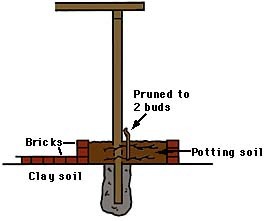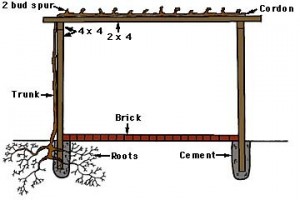George Ray McEachern
Extension Horticulturist
Texas A&M University
Portuguese translation of this page provided by Artur Weber of homeyou.com
Grapes and muscadines have been a part of Texas’ heritage and tradition for many years. Grape arbors were part of the Seaport Mansion Landscape in Galveston and Spanish Mission courtyard in El Paso.
Many homesteads and landscapes over the state still have the grape vine – over the wall, along a back fence, or in the old shade tree.
Arbors Enhance Landscape
At the turn of the Century, T. V. Munson identified 13 of the 27 species growing wild in Texas. Now Texans of the 1990’s are looking again to the grape vine for beauty, food, enjoyment and pride. Grape arbors serve as accents in the landscape, as a passage way or simply a source of shade in recreational areas and to adorn structures.
The tasty grapes you can pick from your arbor are versatile in their use. You can eat them fresh; process them into juice, jelly or wine, or simply have the fruit on the vine for the delight of children and adults.
A grape arbor can be a family project. Its construction, planting of the grape vines, pruning, harvesting and utilizing the fruit help each member learn more about our environment and nature’s way of growing things. For example, the vine goes through four seasonal cycles. It emerges from rest in the spring, grows rapidly in the summer, fruits in the fall and becomes dormant in the winter.

Figure 2. A dormant, 1-year-old vine, with the strongest cane selected as a trunk and all side canes tip pruned.
Young grape vines should be planted on well-drained sandy loam soil in February or March. If a heavy clay is the only type available, a 6-inch elevated container can be constructed and filled with commercial potting soil, figure 1. With the roots eventually growing into the existing clay soil, the potting soil will give the vine a strong, early start.
At planting, grapes should be pruned back to two buds. Do not prune muscadines. As the vine begins to grow, select the strongest cane and train it up the arbor post, figure 2. All side canes should be tipped to simulate the trunk. During the second and third year, allow one trunk to develop, with all the side canes pruned off as they develop. A single cane should be selected to grow across the arbor to form the cordon.
Can Grow in Little Space
Grapes can be grown even in very little space. One vine could be used in a cubic yard of soil with a small amount of direct sunlight. A standard arbor as illustrated here could be established in an 8′ x 8′ area. Larger arbors could be developed as desired.
Grapes and muscadines can be grown on an unpruned natural arbor or a well pruned maintained arbor. Each could be trellised onto the type of structure illustrated in figures 3, 4 and 5.
The natural arbor is permitted to grow randomly, forming a thick mass of canes. There is very little upkeep and the vines produce a dense shade. Since the vines are not pruned annually, there would be significantly fewer grapes produced.

Figure 3. A side view of a grape arbor with a dormant mature vine pruned to an arbor cordon.
The maintained arbor is covered by vines which are pruned to a two-bud spur-type cordon, figures 3, 4 and 5. Prune vines in February or March to a single cordon. Each spur should be pruned to contain two or three buds. Figures 3, 4 and 5 show three mature vines pruned to a cordon system. Grapes should be pruned in this manner every year in February or March. Muscadines should be pruned in November or December to reduce bleeding.
Varieties Adapted
Two varieties of American bunch grapes are well adapted to all of Texas. These are Black Spanish and Champanel. Muscadines are adapted to East Texas and to the Gulf Coast. Any of these varieties can be trained onto an arbor illustrated in figures 3, 4 and 5.
Black Spanish (Lenoir) grows well in all areas of Texas. Vines have yielded as much as 30 pounds each in South Texas and the High Plains. The vines are vigorous and tolerant to many diseases. The small black-seeded grapes form moderately sized clusters. The fruit is susceptible to black rot and requires spraying in East Texas and along the Gulf Coast. The grapes can be eaten fresh or processed.

Figure 5. A top view of an arbor cordon pruning system.
Champanel is a vigorous vine which is well adapted to heavy clay soils. The red grapes form a small loose cluster. The fruit is disease-resistant and usually is processed rather than eaten fresh.
Carlos is a white self-fruitful muscadine which is productive and disease resistant. The fruit can be eaten fresh or processed. Vines have yielded as high as 20 pounds as far west as Austin.
These are the only grapes recommended for home arbors. Other varieties may do well for limited periods but cannot be expected to survive for many years on a state-wide basis.


